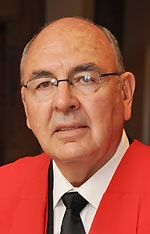 |
| Prof. Kalie Strydom. |
|
No worthwhile contribution can be made to higher education excellence if you do not understand and acknowledge the devastating, but unfortunately unavoidable role of party politics in the system and universities of higher education and training (HET).
This statement was made by Prof. Kalie Strydom during his valedictory lecture made on the Main Campus of the University of the Free State (UFS) in Bloemfontein recently.
Prof. Strydom, who was awarded an Honorary Doctorate by the UFS in 2010, presented a lecture on the theme: The Long Walk to Higher Education and Training Excellence: The Struggle of Comrades and Racists. He provided perspectives on politics in higher education and training (HET) and shared different examples explaining the meaning of excellence in HET in relation to politics.
“At the HET systems level I was fortunate to participate in the deliberations in the early nineties to prepare policy perspectives that could be used by the ANC in HET policy making after the 1994 elections. At these deliberations one of the important issues discussed was the typical educational and training pyramid recognised in many countries, to establish and maintain successful education and training. The educational pyramid in successful countries was compared to the SA “inverted” pyramid that had already originated during apartheid for all races, but unfortunately exploded during the 16 years of democracy to a dangerous situation of 3 million out-of school and post-school youth with very few education and training opportunities,” he said.
In his lecture, Prof. Strydom answered questions like: Why could we as higher educationists not persuade the new democratically elected government to create a successful education and training pyramid with a strong intermediate college sector in the nineties? What was the politics like in the early and late nineties about disallowing the acceptance of the successful pyramid of education and training? Why do we only now in the latest DHET strategic planning 2010–2015 have this successful pyramid as a basis for policymaking and planning?
At an institutional level he explained the role of politics by referring to the Reitz incident at the UFS and the infamous Soudien report on racism in higher education in South Africa highlighting explosive racial situations in our universities and the country. “To understand this situation we need to acknowledge that we are battling with complex biases influencing the racial situation,” he said.
“White and black, staff and students at our universities are constantly battling with the legacy of the past which is being used, abused and conveniently forgotten, as well as critical events that white and black experience every day of their lives, feeding polarisation of extreme views while eroding common ground. Examples vary from the indoctrination and prejudice that is continued within most homes, churches and schools; mass media full of murder, rape, corruption; political parties skewing difficult issues for indiscrete political gain; to frustrating non-delivery in almost all spheres of life which frustrates and irritates everyone, all feeding racial stereo typing and prejudice,” said Prof. Strydom.
A South African philosopher, Prof. Willie Esterhuyse, recently used the metaphor of an “Elephant in our lounge” to describe the syndrome of racism that is part of the lives of white and black South Africans in very different ways. He indicated that all of us are aware of the elephant, but we choose not to talk about it, an attitude described by Ruth Frankenberg as ‘colour evasiveness’, which denies the nature and scope of the problem.
Constructs related to race are so contentious that most stakeholders and role-players are unwilling to confront the meanings that they assign to very prominent dimensions of their experience; neither does management at the institutions have enough staff (higher educationists?) with the competencies to interrogate these meanings, or generate shared meanings amongst staff and students (common ground). A good example that could be compared with “the elephant in our lounge” remark is the recent paper of Prof. Jonathan Jansen, Rector and Vice-Chancellor of the UFS on race categorisation in education and training.
According to Prof. Strydom, universities in South Africa are increasingly becoming the battlegrounds for political gain which creates a polarised atmosphere on campuses and crowds out the moderate middle ground, thereby subverting the role and function of the university as an institution within a specific context, interpreted globally and locally.
Striving for excellence, mostly free from the negative influences of politics, in HET, from the point of view of the higher educationist, is that we should, through comparative literature review and research, re-conceptualise the university as an institution in a specific context. This entails carefully considering environment and the positioning of the university leading to a specific institutional culture and recognising the fact that institutional cultures are complicated by many subcultures in academe (faculties) and student life (residences/new generations of commuter students).
Another way forward in striving for excellence, mostly free from politics, is to ensure that we understand the complexities of governing a university better. D.W. Leslie (2003) mentions formidable tasks related to governance influenced by politics:
- Balancing legitimacy and effectiveness.
- Leading along two dimensions: getting work done and engaging people.
- Differentiating between formal university structures and the functions of universities as they adapt and evolve.
- Bridging the divergence between cultural and operational imperatives of the bureaucratic and professional sides of the university.
Prof. Strydom concluded by stating that it is possible to continue with an almost never ending list of important themes in HE studies adding perspectives on why it is so easy to misuse universities for politics instead of recognising our responsibility to carefully consider contributions to transformation in such an immensely complicated institution as the university within a higher education and training system.
Media Release
Issued by: Lacea Loader
Director: Strategic Communication (acting)
Tel: 051 401 2584
Cell: 083 645 2454
E-mail: loaderl@ufs.ac.za
29 October 2010